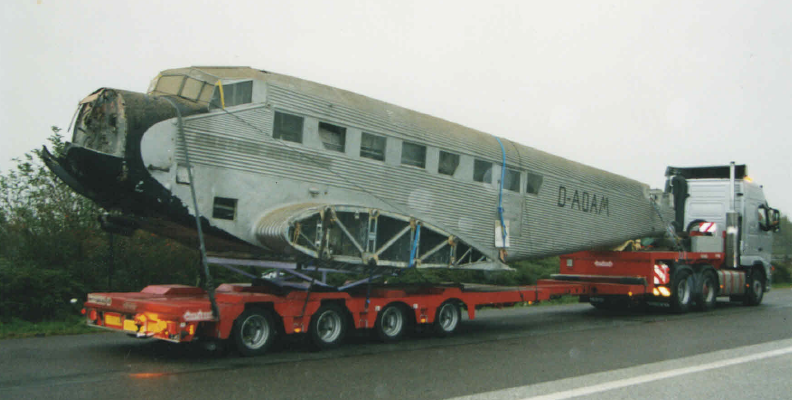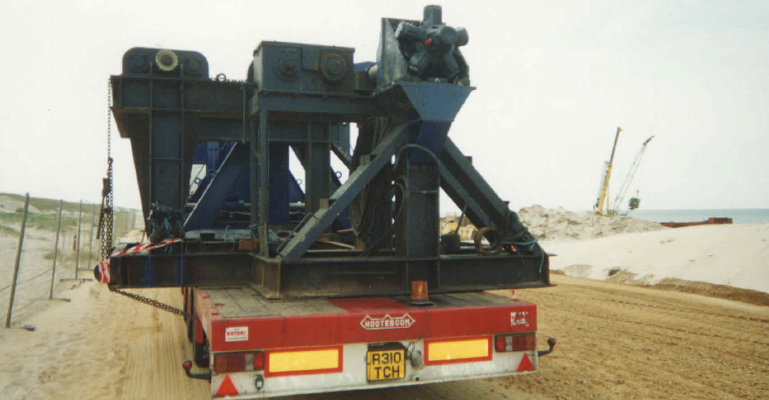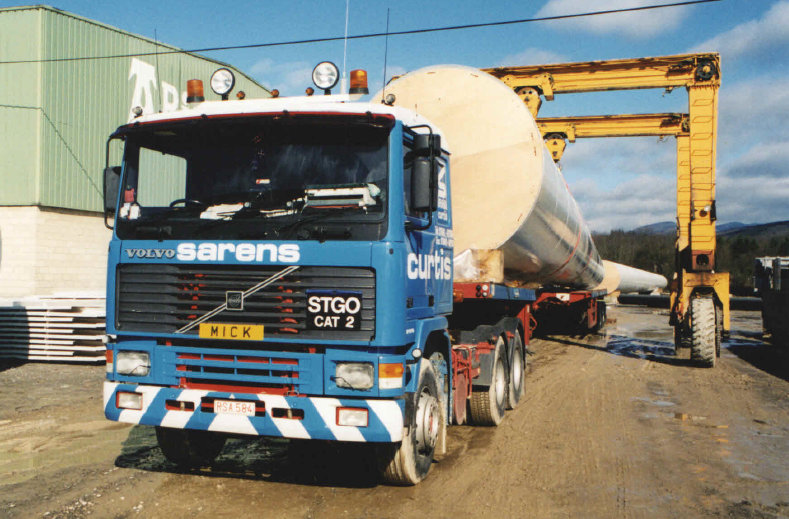Pictured prior to offloading on the Western tip of the island, for filming of the location scenes for ‘Clash of The Titans’ in Tenerife, this replica of Perseus’s ill-fated boat had been delivered all the way from Cornwall by one of our drivers. Two weeks later another of our drivers collected it and returned it to the Exterior Tank at Pinewood Studios, so that it could be filmed being destroyed in front of the huge 73mx18m blue/green screen!

There are restrictions on movement times of abnormal loads in most countries, those in force in the Basque region of Spain meant that as is often the case this load arrived at Bilbao’s Guggenheim Museum in the dead of night. We had previously moved the large, well known modern sculpture from the fabricators in Essex into, and back out of, The Royal Society at Burlington House on Piccadilly in Central London.
Despite it’s German heritage and D registration mark, this ‘Junckers Ju-52’ was actually a Spanish built CASA 352L which changed hands several times in Germany in the 1990s before being put into long term barn storage on a farm near the Danish border. When Paul Allen of MicroSoft fame bought it for restoration we were given the task of repatriating her to Norfolk, along with separately the wings, engines and other parts. Sadly Mr Allen seemed to lose interest in the project, and the aircraft was subsequently sold and transported to a museum in the Netherlands.

XL500 was the identification which this Fairey Gannet aircraft carried throughout it’s career with the Fleet Air Arm, based at RAF Culdrose amongst others – quite some time after her operational career came to an end, we were entrusted with the move from storage at North Weald in Essex to Exeter where restoration was to be carried out. The width of approaching 6 metres, and her unusual (some might say ugly, not us) looks definitely attracted lots of attention on a summer’s evening plod around the M25 and down the M4/M5.

The leaden skies, driving drizzle and single-figure temperature obviously denote that this was a mid August morning in Glasgow – Tennant’s Wellpark Brewery to be precise, the oldest in Scotland and still going strong after numerous changes of ownership. The current owners’ decision to considerably increase capacity saw us deliver 16 large brewing vessels for a long-standing German client, one of the largest projects by number of vessels, if not actual vessel size, which we have worked with them on over a near 20 year relationship.

The narrow back streets of the quaint Suffolk seaside town of Southwold weren’t really designed with articulated lorries in mind, let alone ones carrying pieces of kit at over 6 metres wide – the local trees obviously weren’t designed for their 6 metres plus travelling height either judging by the foliage on the back of the lowbed. The load was part of a State of The Art new brewhouse for Adnam’s Sole Bay Brewery, which is well worth a nosey through the two-storey window included in the renovation, if you find yourself in town and are a bit of an anorak for that sort of thing like we are!
We have been despatching their world renowned bulk materials handling equipment for a Cambridgeshire based client for over 15 years now, to such far-flung destinations as southern Sicily, Saudi Arabia and the Svalbard Islands in the Barents Sea, 500 kilometres north of the northern tip of Norway – this one was only a “local job” destined for Portugal.

It’s quite surprising that at 850 tonnes, the manufacturer of this rock crushing plant classes it as “Semi Mobile” but it does indeed move around (albeit very slowly) it’s Leicestershire home, chewing up and spitting out the particularly hard local granite at the rate of 2500 tonnes per hour. Luckily for us we transported it from the various factories in Poland and Germany in rather more manageable sized pieces, although many were still well over 5 metres wide and all were on a strict sequence and timing to minimise disruption to the fully operational site.

When it comes to installing Onshore or Offshore pipelines, basically pulling long runs of large diameter steel pipe onto or from the shoreline, as you might imagine there is a lot of heavy plant involved. Hydraulic winches weighing over 50 tonnes, reels containing kilometre upon kilometre of steel rope, self-contained powerpacks, and in this case a reel winder frame – about to offload on a windswept beach on the North Sea coast of Denmark.

Whilst not the heaviest at 25 tonnes or widest at 5.50m, these propeller shaft brackets made difficult loads simply due to their shape and resulting Centre of Gravity. Working directly with the specialist foundry who produced them we came up with a loading plan involving two particular trailers, and went on to deliver six pairs to two different shipyards in Poland for newbuild Car Carrier vessels
Regardless of the fact that we are firmly UK based, a good proportion of our cargoes never see these shores, working as we do for a large spread of European and International manufacturers, E&C contractors and specialist freight forwarders. This 21 metre long, 35 tonne process column was loaded from a client in Spain and delivered overland into the main sugarbeet growing region of Slovakia.

There are only a limited amount of foundries remaining in Europe who are capable of producing large, high integrity castings such as this piece of cement making plant delivered door to door from eastern Germany to the Asturias region of northern Spain – one of many along with kiln sections and steel tyres for the kilns moved from, to and across Europe on a regular basis.

We were extremely proud to be closely involved with the British contribution to building the Large Hadron Collider at the CERN facility on the French/Swiss border over a period of over 3 years. None of the pieces, which included the six SCT barrels as well as the ATLAS End Cap which formed the core of the experiment were as such oversized, but they were all extremely valuable and delicate. The End Cap is pictured being loaded into a rollerbed floored, fully air suspended vehicle at the University of Liverpool – several weeks earlier we had taken a mockup of the cargo, covered in many different types of shock detection equipment in the same vehicle to a nearby disused airfield and carried out some fairly extreme emergency stops and sharp turns, so that the project staff were satisfied that the whole packing/method/vehicle was suitable to deliver their ‘baby’ to destination safely.

Believe it or not, this 6 metre diameter solid stainless steel dish is the oversized equivalent of a contact lens bath, but this one is for cleaning the lenses of the ESO’s Very Large Telescope at the Paranal Observatory located high in the Atacama Desert in Chile. After loading and transporting the dish to Yorkshire for machining, we returned it to the manufacturer in Cambridgeshire for finishing, before despatching to it’s final destination via the ports of Antwerp and Antofagasta.

An ever more contentious issue these days, we have been involved with wind turbines ever since some of the first to be installed in the UK back in the 1990s when they were arguably a novelty and seen as something different to adorn the rural skyline. This 25 metre tower top pictured loading from the paintshop in the Alava region of Spain was one of three for the Kirkheaton Wind Farm in Northumberland.

The single turbine development for which this tower section was destined wasn’t actually situated at the altitude which the early morning Cornish mist might suggest – Steve and Paul are also adamant they were simply discussing the best way to manoeuvre through a tight section, and that they were in no way lost on the moors above Wadebridge….

